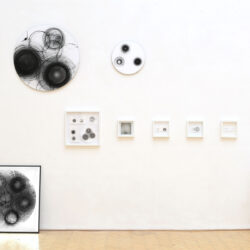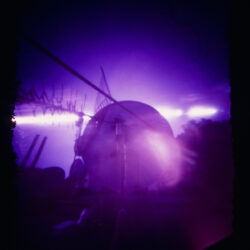Camera obscura, fotópapíron, síkfilmen – képeredetik, print, lightbox, változó méretek. 2017 – 2019.
Analóg fotósorozat, diavetítés, különböző méretek, 2019. Kép a sorozatból.
The development and realisation of the Intermedia Program’s curriculum was started by János Sugár, the current head of the department and Miklós Peternák, the curator of this exhibition, cooperating closely with the students.
The initial period of the department was most like an experimental workshop; the teachers, who were prominent Hungarian representatives of contemporary culture, trained the students following a flexible syllabus. In the complex educational program, great care was taken to organise special art events as well as to invite international lecturers and artists.
In addition to social changes, the history of the intermedia specialisation is also in parallel with the spread of the Internet and interactive techniques, the total and global transformation of communication and imaging devices, the technical media as a whole.
From the very beginning, the Intermedia Program has considered its task to expand art education to art forms and art techniques that first appeared in 20th-century fine art, such as photokinetic and electronic arts, multimedia, installation and action arts, as well as new communication techniques.
The aim of the “Eppur si movie! – IMXXX” jubilee exhibition is not to fully cover the history of the intermedia department; instead, both in the exhibition hall and on the virtual platforms, it focuses on students’ works made for this exhibition, giving shapshots of some events, personalities and works in the history of the Intermedia Program.
The distinctive feature of the Intermedia Program is that the use of any technique, method or medium suitable for artistic expression is permitted. For this show we have chosen the medium of the film, the moving image as the central element, as the most radical transformation of the last three decades can be attributed to it.
Exhibitors: Bácsi Barnabás, Barnaföldi Anna, Csököly Adél, Hoóz Anna, Kovács Gyula A., Lestál Hella, Melykó Richárd, Pátkai Rozina, Plesznivy Ákos, Szécsényi-Nagy Loránd, Tihanyi Áron, Tulisz Hajnalka, and many former and current students of the department in the form of collective projects.

